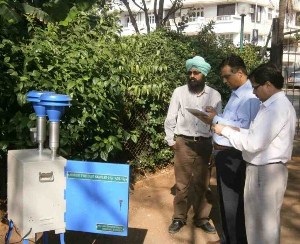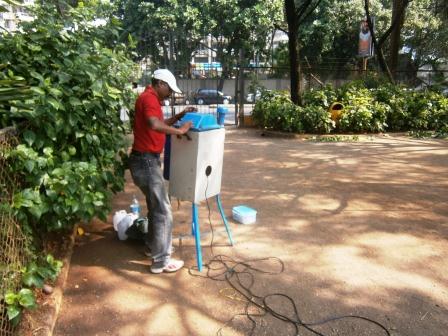Ambient Air Quality monitoring or Testing is a process of measurement of pollutants present in the atmosphere. It measures the healthiness and safety of our environment.
Monitoring ambient air quality is essential for assessing pollution levels, ensuring compliance with CPCB/SPCB standards, and safeguarding public health.
With over 25 years of expertise, Perfect Pollucon Services provides precise air quality monitoring solutions, helping industries, municipalities, and regulatory bodies track pollution trends and ensure compliance.
Ambient air quality testing is a critical process that involves measuring the concentration of pollutants in the air we breathe. With urbanization, industrialization, and rising vehicular emissions, understanding and monitoring air quality has become more important than ever. This article will delve into the significance of ambient air quality testing, the methods used, the pollutants commonly monitored, and the benefits of ensuring clean air for public health and the environment.
What is Ambient Air Quality?
Ambient air quality is defined as the quality of air outside and sometimes inside. Ambient air quality standards are limits to concentrations of pollutants in air stated for well being of human, nature, animals, etc. There is no single specified definition of standards resulting, Various organizations use standards which are not often similar. Ambient air quality monitoring is also called as Outdoor Air Quality Testing.
What is Air Quality Monitoring?
Air quality monitoring is the process of assessment of pollutants present in the atmosphere by their quantity and types as per air quality standards. Air quality monitoring helps us to take action based on pollutants present in atmosphere to improve air quality
Why Ambient Air Quality Monitoring or Testing Required?

Air Pollution is the introduction of Chemicals, Particulates or other Harmful materials into atmosphere causes/damage to living organism/Built Organism. Air pollutants are added in the atmosphere from a variety of sources that change the composition of the atmosphere and affect the biotic environment. The concentration of air pollutants depends not only on the quantities that are emitted from air pollution sources but also on the ability of the atmosphere to either absorb or disperse these emissions. The sources of air pollutants include vehicles, industries, domestic sources and natural sources. Because of the presence of a high amount of air pollutants in the ambient air, the health of the population an
property is getting adversely affected. In order to arrest the deterioration in air quality, Govt. of India has enacted the Air (Prevention and Control of Pollution) Act in 1981. The responsibility has been further emphasized under the Environment (Protection) Act, 1986. Therefore, the Central Pollution Control Board had started National Ambient Air Quality Monitoring (NAAQM) Network during 1984 – 85 at the national level. The program was later renamed as National Air Quality Monitoring Program (NAMP).
Common Mistakes in Ambient Air Quality Monitoring
Top mistakes in air quality monitoring:
🔸 Ignoring seasonal variations, leading to inconsistent data.
🔸 Using outdated or uncalibrated monitoring equipment.
🔸 Failing to maintain proper sampling frequency, missing pollution spikes.Perfect Pollucon Services helps industries avoid these errors, ensuring accurate data and regulatory compliance.
Ambient Air Quality Monitoring & Testing Methodology

Ambient air quality monitoring & testing is required to determine the existing quality of air, evaluation of the effectiveness of the control program. National Air Quality Monitoring Program is described in this chapter along with details on pollutants measured and their frequency. Similarly, Guidelines for monitoring are made for carrying out AAQM under NAMP and description of the program is essential as the monitoring is carried out to meet the objectives of NAMP.
Various methods are employed for ambient air quality testing, each suited to different pollutants and situations:
- Passive Sampling: Involves using absorbent materials that passively collect pollutants over time. This method is low-cost and ideal for long-term monitoring.
- Active Sampling: Utilizes pumps to draw air through filters or adsorbents. This method is more precise and can measure specific pollutants over shorter periods.
- Continuous Monitoring Stations: Fixed stations equipped with advanced instruments provide real-time data on air quality. They are essential for tracking pollution trends and providing alerts during poor air quality events.
- Mobile Monitoring: Vehicles equipped with monitoring equipment can measure air quality across different locations, helping identify pollution hotspots.
Various types of equipment are used to find the amount of Air pollution done by a particular source called ‘’Air Monitoring Equipment.’’ Evaluation of Ambient Air for determination of community air Quality as related to local health, Social & Environmental Effects. Determination of suspended particulate matter as small as one-micron size & any four gaseous contaminants at a time.
🔍 What Could Be Causing High PM2.5?
Industrial
Residential
Possible Source: —
The Role of Technology in Air Quality Testing
Recent advancements in technology have significantly improved ambient air quality testing. Innovations include:
- Smart Sensors: Affordable and portable sensors can be deployed in various locations, providing real-time data on air quality.
- Data Analytics: Advanced software can analyze vast amounts of air quality data, helping to identify trends and predict pollution events.
- Mobile Apps: Many cities now offer apps that provide real-time air quality information to the public, allowing individuals to make informed decisions about outdoor activities.
Ambient Air Quality Monitoring or Testing Parameters
Under N.A.M.P., 12 air pollutants viz., Sulphur Dioxide (SO2), Oxides of Nitrogen as NO2 and Particulate Matter (PM10) and Particulate Matter (PM2.5), Ozone (O3), Lead (Pb), Carbon Monoxide (CO), Ammonia (Nh3), Benzene (C6H6), Benzo-Pyrene (BaP), Arsenic (As), Nikhel (Ni) have been identified for regular monitoring at required the locations/ Industrial unit.
Among all these parameters Particulate matter is the most important pollutant present in the atmosphere. It is also called as Particulate matter Monitoring or Dust Monitoring.
As per CPCB Notification under National ambient air quality testing standards (NAAQS). These Results can be converted into the non-Technical way so that everybody can understand the level of pollution. it is called as Air Quality Index (AQI).
Ambient Air Quality Monitoring or Testing Standards
Below mentioned are National Ambient or Outdoor air quality standards (NAAQS Standards) which are used in ambient air testing.
| Parameters | Unit | Limit |
|---|---|---|
| Sulphur Dioxide (SO2) | mg/M3 | ≤ 80 |
| Oxides of Nitrogen | mg/M3 | ≤ 80 |
| Particulate Matter PM10 | mg/M3 | ≤ 100 |
| Particulate Matter PM2.5 | mg/M3 | ≤ 60 |
| Ozone (O3) | mg/M3 | ≤ 180 |
| Lead (Pb) | mg/M3 | ≤ 1.0 |
| Carbon Monoxide (CO) | mg/M3 | ≤ 04 |
| Ammonia (NH3) | mg/M3 | ≤ 400 |
| Benzene (C6H6) | mg/M3 | ≤ 05 |
| Benzo(a)Pyrene (BaP) | mg/M3 | ≤ 01 |
| Arsenic (As) | mg/M3 | ≤ 06 |
| Nickel (Ni) | mg/M3 | ≤ 20 |
📋 Check CPCB NAAQS Limit
Limit: —
Ambient Air Quality Testing Procedure – Duration and Frequency
The period and frequency of ambient or outdoor air quality sampling procedure should be such that statistically reliable averages can be obtained with the data i.e. 8 Hrs or 24 Hrs. National Ambient Air Quality Standards (NAAQS) states that it should be 8 Hrs monitoring or 24 Hrs as per requirement. Particulate matter levels are lower during the monsoon months due to removal by wet deposition. Air pollutants such as CO levels are higher during winter months due to lower mixing heights resulting in less volume of troposphere available for mixing and hence higher concentrations. Thus measurements should be conducted in all the seasons so that in annual average all the seasons are represented equally. In general, a minimum of 20% of the reading should be taken in each season.
Ambient Air Quality Monitoring Equipment
There are many types of instruments available to monitor ambient air quality such as Respirable dust samplers, High volume air samplers, Handy dust samplers, Combined dust samplers, Portable air quality analyzers, etc. Below are the few Ambient Air Quality Monitoring instruments commonly used in the industry
High Volume Air Sampler
High Volume Air Sampler consists of the filter holding assembly, High capacity blower, U-tube Manometer, Rotameter, impingers housed in detachable fibre case, inlet filters, voltage stabilizer & Timer.
Continuous Air Quality Monitoring Station
Continuous air quality testing station or ambient air quality monitoring station constantly samples and test ambient air and provide instant reading to the nearest monitoring center. Recently the Indian government has installed more than 50 continuous air quality monitoring stations in Metro cities of India.
🤔 Should You Do Ambient Air Monitoring?
- Your industry is Red Category
- You’re applying for Consent to Operate
- You have on-site emission sources (boilers, DG sets)
- You’re close to a residential or sensitive zone
If you checked 2 or more, AAQM may be mandatory.
Ambient Air Quality Monitoring System manufacturers in India
Here are some well-known Ambient Air Quality Monitoring System manufacturers in India:
- Ecotech Instruments India Pvt. Ltd.: A prominent manufacturer of environmental monitoring instruments, including ambient air quality monitoring systems. They offer a range of products to measure various pollutants like PM2.5, PM10, SO2, NO2, CO, O3, and more.
- Envirotech Instruments Pvt. Ltd.: Envirotech is a leading manufacturer and supplier of environmental monitoring instruments, including ambient air quality monitors. They provide advanced solutions for real-time air quality monitoring.
- Horiba India Pvt. Ltd.: Horiba is a global company with a presence in India, offering a range of environmental monitoring solutions, including ambient air quality monitoring systems.
- Ecotech Instruments (India) Pvt. Ltd.: Another division of Ecotech Instruments focused on providing high-quality ambient air quality monitoring solutions.
- MNM Environmental Consultants Pvt. Ltd.: MNM offers a wide range of environmental monitoring instruments, including ambient air quality monitoring systems, to measure various pollutants and parameters.
- Vasthi Instruments Pvt. Ltd.: Vasthi specializes in providing environmental monitoring solutions, including ambient air quality monitors, gas analyzers, and dust monitors.
- Apzem India Engineering: Apzem manufactures ambient air quality monitoring systems and gas analyzers to measure pollutants in the atmosphere.
- Emtici Engineering Ltd.: Emtici Engineering provides environmental monitoring instruments, including ambient air quality monitoring systems, for various industrial applications.
- SPM Instrument India Pvt. Ltd.: SPM Instrument offers a range of environmental monitoring solutions, including ambient air quality monitors and dust monitors.
- Met One Instruments India Pvt. Ltd.: Met One Instruments is known for its high-quality air quality monitoring instruments, including ambient air quality monitors and particulate samplers.
💨 Estimate Air Pollution Risk
Status: —
Ambient air monitoring equipment
Ambient air monitoring equipment is used to measure the quality of the air we breathe by detecting pollutants like dust (PM2.5, PM10), gases (CO, SO₂, NO₂), and other harmful substances. These tools help industries, governments, and researchers track pollution levels and take action to improve air quality. At Perfect Pollucon Services, we have been using and recommending the best monitoring equipment for over 25 years.
One key lesson we’ve learned is that real-time monitoring is much more effective than occasional testing, as it helps identify pollution patterns and sources. Many businesses make the mistake of using outdated or poorly placed monitors, which can give inaccurate readings. To get the most reliable results, we suggest placing sensors in high-risk areas and using automated monitoring stations that provide continuous data. Whether you need air monitoring for an industrial site, a city, or a workplace, having the right equipment makes a big difference in ensuring cleaner, healthier air for everyone.
These manufacturers offer a variety of products and solutions for ambient air quality monitoring, catering to different industries, government agencies, research institutions, and environmental consulting firms. When selecting an ambient air quality monitoring system, it's essential to consider factors such as the specific pollutants you need to measure, the accuracy and reliability of the instruments, data logging capabilities, and compliance with relevant national and international standards.
CPCB guidelines for Ambient Air Quality monitoring latest
Learnings from 25 Years of Air Quality Monitoring
✅ Real-time monitoring improves response time to pollution events.
✅ Strategic sensor placement enhances data accuracy by 30-50%.
✅ Industries using automated monitoring reduce compliance violations by 40%.With extensive experience, Perfect Pollucon Services ensures reliable air quality assessments and regulatory adherence.
Ambient Air Quality Monitoring PDF by Perfect Pollucon Services
The Ambient Air Quality Monitoring guidelines published by the Central Pollution Control Board (CPCB) serve as a critical reference for standardized methods of real-time sampling, analysis, and reporting of various air pollutants across India. These guidelines outline procedures for accurate measurement of pollutants such as Particulate Matter (PM10 & PM2.5), Sulfur Dioxide (SO₂), Nitrogen Oxides (NO₂), Carbon Monoxide (CO), Ozone (O₃), and other hazardous substances.
Emphasizing robust Quality Assurance and Quality Control (QA/QC) practices, calibration methods, and data management protocols, the document ensures reliable air quality data collection. Perfect Pollucon Services adheres strictly to these CPCB guidelines, providing clients with precise and regulation-compliant Ambient Air Quality Monitoring solutions.
Benefits of Ambient Air Quality Testing
Improved Public Health: By identifying and mitigating pollution sources, air quality testing can reduce health risks and improve overall community well-being.
Environmental Conservation: Monitoring air quality helps protect ecosystems and biodiversity from the harmful effects of pollution.
Policy Development: Accurate data supports the development of effective environmental policies and regulations, driving improvements in air quality management.
Community Engagement: Sharing air quality data with the public fosters awareness and encourages community action toward improving air quality.
Ambient Air Monitoring & Testing Services Company
We offer Ambient air monitoring & Testing Services in India. Our Company is completely adept in offering customized ambient air monitoring services as per clients requirements. All this was possible because, We have highly qualified and experienced professionals who are capable of monitoring the air for toxin level, pollution degree etc.
Special features of Perfect Pollucon Services are:
- Customized service offered
- Excellent monitoring
- Specialized services
- Efficient professional team
- Cost-effective
- Timely Service
- Reliable
Perfect Pollucon Services specializes in:
✅ Regulatory compliance monitoring as per CPCB/SPCB norms.
✅ Real-time & periodic air sampling for precise pollutant measurement.
✅ Customized air quality monitoring solutions for industrial and urban environments.
Our expertise helps organizations reduce environmental impact and ensure compliance.
✅ Reviewed by Our Expert Leadership Team
This service offering is created and reviewed by our senior team of environmental professionals with 10–40 years of experience in pollution control, regulatory compliance, and monitoring services.

Tanaji S. Gajare
Founder & Chairman
40+ years in air & water monitoring, sustainability leadership

Anil Shelke
Executive Director
30+ years in compliance, audits, and ETP/STP operations

Kunal Gajare
Environmental Engineer
10+ years in stack monitoring, MPCB/MoEF clearances, EIA
Also, we have periodically calibrated instruments as per Pollution control board guidelines. As Environmental Consultants We offer services in Soil Analysis, Water Analysis, Environmental Monitoring, Air Quality Monitoring, Ambient Noise level Monitoring and Stack Emission Monitoring.
As per CPCB parameters of air quality monitoring are Particulate Matter (PM10, PM2.5), NO2, CO, O3, SO2, NH3, Pb, As, Ni, Benzopyrene and Benzene. Mostly parameters like PM, SO2, CO, CO2, O3 and NH3 are reported.
The process of Air quality measuring is combining multiple pollutants levels present in the atmosphere and then combining their reading with their weightage assigned by pollution control boards. This gives information on air quality to the public whether air quality is either good, moderate, or hazardous.
As per CPCB notification, the fourth version of the National Ambient Air Quality Standards (NAAQS) is used for ambient air quality monitoring.
Ambient air quality monitoring is the process of collecting, measuring ambient air pollutants to evaluate the current status of the environment, and comparing them to standards declared by government agencies.
There are many types of ambient air quality monitoring such as high volume sampler, handheld devices, passive monitoring, continuous monitoring, active sampling using silica gel etc. Then to make understand these results for common people it is converted into Air Quality Index i.e., scoring system.
a. It helps us assess impacts caused by poor air quality on public health
b. It helps us to understand if air quality is within standards or not
c. To Identify polluted areas, level of pollution
d. The efficiency of industries in high polluted areas
e. Assess health issues on people due to pollution
f. To design control measures for better health of livings
The four mandatory parameters as per the National Ambient Air Quality Standards (NAAQS) are Particulate Matter (PM10 and PM2.5), Sulfur Dioxide (SO₂), Nitrogen Dioxide (NO₂), and Carbon Monoxide (CO). These pollutants are monitored to determine air quality levels and their impact on human health.
Federal Reference Method (FRM) is a precise and approved method for measuring air pollutants, using standardized techniques for regulatory compliance. Federal Equivalent Method (FEM) uses alternative techniques that provide comparable results but offer advantages such as automation and continuous monitoring.
Ambient air quality is monitored using manual sampling techniques (like gravimetric analysis) or Continuous Ambient Air Quality Monitoring Systems (CAAQMS) that provide real-time pollutant data. Various monitoring stations are set up in industrial, urban, and rural areas to track pollution trends.
The two main types are ambient air monitoring, which assesses overall air quality in an area, and source-specific monitoring, which measures emissions directly from industrial stacks, vehicles, or specific sources.
Air quality is calculated using the Air Quality Index (AQI), which consolidates multiple pollutant concentrations into a single number on a scale from 0 to 500. Higher AQI values indicate worse air quality, with thresholds for health advisories.
The main objectives include assessing pollution levels, identifying sources of air pollution, evaluating regulatory compliance, and developing strategies for air quality management. Monitoring helps protect public health and ensures environmental sustainability.
Air quality monitoring stations equipped with analyzers such as High-Volume Samplers, Continuous Ambient Air Quality Monitoring Systems (CAAQMS), and real-time gas detectors are used to measure air pollutants.
The Central Pollution Control Board (CPCB) in India sets air quality standards, while global organizations like the World Health Organization (WHO) and the Environmental Protection Agency (EPA) also define regulatory limits.
The five common parameters include PM10, PM2.5, NO₂, SO₂, and CO, which are key indicators of air pollution levels and their impact on health and the environment.
IAQ stands for Indoor Air Quality, which refers to the air quality inside buildings and enclosed spaces, often monitored for pollutants like CO₂, VOCs, and mold.
CFD (Computational Fluid Dynamics) is a simulation tool used to analyze airflow and pollutant dispersion, while FEM (Finite Element Method) is a numerical technique for solving complex engineering problems, including air quality modeling.
CFA (Continuous Flow Analysis) is a method used for real-time air pollutant monitoring, whereas FRM (Federal Reference Method) is a regulatory-approved method that provides highly accurate but periodic pollutant measurements.
Auto FEM (Automated Federal Equivalent Method) refers to advanced real-time monitoring instruments that continuously measure pollutants with minimal human intervention. FEM (Federal Equivalent Method) includes both automated and manual alternative methods that provide results equivalent to FRM.
If you have any questions or want to know more about our Environmental Quality Monitoring services then, please fill up below form.
Share this Article with your friends and family !
In addition, you can Also read More What is Air Quality monitoring?


What is monitoring frequency as per norms or act
Hi Amit,
The Monitoring frequency depends on the category of your company falls in. for example Red category company has to conduct monitoring more frequently as compared to green category company. it can vary from Monthly/Quarterly/half yearly etc.
for more information you can contact us.
Thank You,
Perfect Pollucon Services
what is used for PM2.5 monitoring
Hi Neelima,
We use high volume sampler as well as digital smart high accuracy sampler to monitor PM 2.5.
Thanks
We are residents living in Lodha New Cuffe Parade in wadala and looking to hire a consultant /agency to monitor air quality in our area and give us a strong report that we can take it to the right authorities for taking corrective action. – move RCF ans other refineries out of wadala.
Thank you Vidhya for your response.
Request you to call on 9930180059 for faster response.
Thanks You,
Perfect Pollucon Team
What is different between the pm 10 and pm 2.5
Hi Ram,
PM10 has a size of 10 micrometres whereas PM2.5 has a size of 2.5 micrometres. A human hair is can be of 100 micrometres, so around 40 PM2.5 could be placed on its width
Thanks,
Perfect Pollucon Services Team
Why 8 hour and 24 hour for AAQM
what are the basis in monitoring air parameters
Hi Roy,
Different pollutants affect human and environment in different ways. To control impact of those pollutants on our life Pollution control boards has defined certain procedures to monitor all pollutants. That is the basis of Air Parameters monitoring.
Thank you,
PPS Team
Hi,
what are the requirements to siting the AAQ monitor in industry.
Hi Manikandan,
When siting an Ambient Air Quality (AAQ) monitor in an industrial setting, it should be placed in an area that provides representative air quality data while avoiding localized pollution sources like chimneys or exhaust vents. The monitor should be positioned between 1.5 to 15 meters above the ground and located away from obstructions like buildings or trees. It is recommended to keep the monitor at least 50 to 200 meters from major pollution sources and ensure easy access for maintenance and calibration.
Thanks
TeamPPS
I want to test Indoor Air quality at specific time do you provide such services
Hi Mahadev,
Request you to get in touch with our team for more information. Thanks